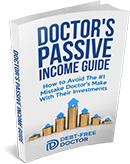VTSAX vs VOO – Which One Is Better?
As long as I can remember, I’ve always had an interest in investing. Maybe it stems from my “lawn mowing” days in high school, where I learned firsthand that working for myself and making my own money was the way to go.
I loved working on my own schedule and not someone else’s. One of the things I realized while living at home with minimal expenses was how quickly money was coming in from mowing yards, yet sitting dormant in a checking account.
This inspired me to educate myself about how to get my money working for me, which led me to Vanguard mutual funds.
Not only do they have a large selection of funds, but their extremely low expense ratios make them one of the most popular mutual fund companies in the world.
In this article, we’re going to take a look at two of Vanguard’s funds: VTSAX vs. VOO
Don’t Miss Any Updates. Each week I’ll send you advice on how to reach financial independence with passive income from real estate.
Sign up for my newsletterWhat Is An Index Fund?
If you’ve read any of my articles, you know that I’m all about investing passively in assets that will eventually lead to financial freedom.
Although most of our monthly income is allocated to real estate syndications, we also fund the practice’s retirement plan, which primarily consists of index funds.
Want to learn more about my favorite passive real estate investment? Check out this video:
Index funds are a type of investment fund that aims to match the performance of a specific market index. Instead of picking individual stocks, the fund buys all (or most) of the stocks in that index.
For example:
- VTSAX tracks the CRSP U.S. Total Market Index, which includes nearly the entire U.S. stock market.
- VOO follows the Standard & Poor’s 500 Index (S&P 500), focusing on the 500 largest U.S. companies by market capitalization.
These funds are ideal for passive investors who want to avoid the stress of technical analysis and picking winners.
Index funds offer:
- Low-cost exposure to the market
- Fewer transaction costs than active funds
- Lower capital gains distributions
- Long-term growth potential
These funds are typically purchased through platforms such as:
- Vanguard (my favorite)
- Fidelity
- Merrill Lynch
- Charles Schwab
Vanguard’s History
Because we’re going to discuss two of Vanguard’s more popular funds, let’s take a brief look at how they were started.
The late Jack Bogle founded Vanguard in 1975. What makes Vanguard so unique is that its investors are the owners. Because of this structure, they’re able to reinvest profits and keep costs ultra-low.
Today, there are websites and forums of loyal “Bogleheads” that continue to follow his low-cost, index fund investing principles.
In 1976, Bogle was credited as starting the first index fund, the Vanguard 500 Index Fund (VFINX).
Back then, the common investment practice was either buying individual stocks or hiring an advisor to manage your portfolio. Bogle created quite a ruckus as he was looked upon as someone who conceded to match the market instead of trying to beat it.
Thanks to Bogle’s vision, Vanguard became known for offering low-cost funds, efficient share classes, and investor-friendly fee schedules.
Today, it’s one of the best-known names in investing, especially among individual investors. Vanguard brokerage services continue to offer popular choices like VTSAX and VOO with low expense ratios and excellent after-tax returns.
What is VTSAX?
VTSAX (Vanguard Total Stock Market Index Fund Admiral Shares) is one of the most popular traditional mutual funds in the United States. It provides access to the entire U.S. stock market in a single fund.
It’s the world’s largest fund and is known for its:
- low costs
- broad diversification
- potential for tax efficiency
Key Features
- Tracks the CRSP U.S. Total Market Index
- Holds over 4,000 U.S. stocks
- Includes small-cap stocks, mid-cap stocks, and large-cap stocks
- Sectors include tech companies, healthcare, energy, industrials, and more
- Requires a $3,000 minimum investment
- Trades once per day at net asset value (NAV)
- Allows fractional share purchases, which is a benefit over ETFs
This fund is great for risk-tolerant investors who want broad exposure to the full market—from smaller companies to larger companies.
The diversification and scale make it an excellent long-term option with strong past performance.
What is VOO?
VOO (Vanguard S&P 500 ETF) is an exchange-traded fund (ETF) that tracks the performance of the S&P 500 Index, which focuses on the largest, most established American companies by market capitalization.
Key Features
- Tracks the S&P 500, made up of 500 large-cap stocks
- Includes leaders across tech, healthcare, financials, and consumer sectors
- Trades like a stock throughout the day on the secondary market
- No minimum investment (just the cost of one share)
- Lower current expense ratios than many mutual funds
Since VOO is an ETF, it offers more flexibility. It’s a top choice for newer investors who want to get started quickly or invest through non-Vanguard brokerage accounts.
Vanguard ETF shares also make it easier to trade during the day, which is helpful for those watching volume and price trends.
VOO vs VTSAX – Main Differences
While both funds are based on low-cost index fund principles, there are some noticeable differences:
| Feature | VTSAX | VOO |
|---|---|---|
| Fund Type | Traditional mutual fund | Exchange-traded fund (ETF) |
| Index Tracked | CRSP U.S. Total Market Index | S&P 500 (Standard & Poor’s) |
| Holdings | 4,000+ (broad market) | 500 (mostly large-cap) |
| Minimum Investment | $3,000 | None (just price of one share) |
| Trading | Once daily at NAV | Trades throughout market hours |
| Share Class | Admiral Shares | ETF Shares |
| Capital Gains Efficiency | Slightly less tax-efficient | Slight edge for taxable accounts |
| Redemption Fees | Possible with short-term redemptions | None through Vanguard |
| Best For | Broad diversification, long-term portfolios | Flexibility, tax efficiency, liquidity |
Fund Type
VTSAX is a total US stock market fund, whereas VOO is an S&P 500 fund.
A total stock market fund offers slightly more diversification but also slightly higher risk. This is due to them holding smaller and mid-sized companies.
They are generally viewed as riskier because they have more opportunities to grow, but also have a higher likelihood of failure.
VOO attempts to match the S&P 500 index set by Standard and Poor’s. It simply carries the top 500 companies in the United States.
Despite these slight differences, it’s worth noting that Vanguard rates both funds at the same risk level and both have provided very similar returns over the past 5 years.
ETF vs Index Fund
VTSAX is an index fund, whereas VOO is an exchange-traded fund (ETF). Typically, ETFs are the more accessible option for new investors since they don’t have a minimum investment.
ETFs are also available to trade at any time the market is open, whereas index funds are bought after the market closes.
For long-term investors, the ability to trade at any time during the day shouldn’t make much of a difference.
ETFs must be purchased one full share at a time, which can occasionally lead to money left uninvested. But index funds offer fractional share buying, which allows you to invest the total amount you want at that time.
Which One Should You Choose?
If you’re trying to make the right investment decision, here are some tips:
Choose VTSAX if:
- You want exposure to the entire U.S. stock market
- You prefer mutual fund transactions
- You meet the minimum investment requirements
- You value broad market coverage and asset class variety
Choose VOO if:
- You want access to the 500 largest U.S. companies
- You prefer ETFs and daily trading flexibility
- You want slightly better after-tax returns in a taxable account
- You’re investing through another broker or want to avoid minimums
Both are solid choices and offer low-cost exposure to U.S. equities. Even Warren Buffett has recommended investing in the S&P 500 for most people.
For many investors, VOO may be the ETF equivalent of a simple, effective investment strategy.
Final Thoughts
When comparing VTSAX vs VOO, there isn’t a single best answer. They’re both built for passive investors who want to keep costs low and grow their money steadily over time.
Whether you go with the Vanguard Total Stock Market Index Fund Admiral Shares (VTSAX) or the Vanguard S&P 500 ETF (VOO), you’re making a good choice.
As always, if you’re making a significant investment, talk to a certified public accountant (CPA) or financial advisor for personalized advice. And remember: the most important thing isn’t which fund you pick — it’s that you stay consistent and keep investing.
Join the Passive Investors Circle


